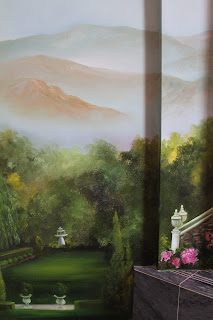My interest in Rome actually started with an interest in ancient Egypt and it's most famous pharaoh, Cleopatra. I saw a book at the library called "Antony and Cleopatra" by Colleen McCullough and decided to check it out. It was dry. Up until then, the only history I had read was in a school history book; but the content was interesting even if there were a lot of boring minutia, so I kept reading. Eventually all the details started coming together and making sense, and the book became really enjoyable. I finished it and the rest of the series in conjunction with the actual works of the time (Caesar, Plutarch), then moved on to other historical fictions. Right now I'm reading a lot of academic histories, mostly around the time of Julius Caesar.
Despite all of this, I have never actually been to Rome! So you can imagine how cool the Roman room was for me. The following is my analysis on the decor included in the room based on what I've learned so far. Please correct me if I'm wrong!
 |
| A bust of my favorite Roman general, Gaius Julius Caesar! |
 |
| Hercules and the Nemean Lion |
While Hercules originated in Greece as the divine hero Heracles, Rome eagerly adopted him into their own mythology. He became so much a part of Roman life, there were feasts and multiple temples dedicated to him (one of which stands today- the
Temple of Hercules Victor). This shield depicts him slaying the Nemean lion. This was one of Hercules' "twelve labors" he went through to earn atonement and immortality.
 |
| The Great Fire of Rome |
This scene is obviously the burning of Rome. But
where was Nero and his infamous lyre? Andy and I spent a long time
searching the mural for him. Our room came with an information binder
that I hoped would tell us a little bit more about the artwork. While it
didn't say much about the art, it did confirm that there was a
painting somewhere of Nero watching as Rome burned. We actually found it
in the bathroom.
 |
| Emperor Nero playing the lyre as Rome burns. |
Here's the rest of the mural surrounding a burning Rome. I tried checking some maps to see if the buildings corresponded to anything, but I didn't have much luck.
 |
| "Discobolus of Myron" |
This statue is a weird one for the room since the original is a Greek work called "Discobolus of Myron". I guess there were multiple Roman copies though.
 |
| ??? |
This statue has me stumped. The only Roman deity associated with grapes is Bacchus, the god of wine, and that definitely is not a man, although he is sometimes pictured with longer hair like this. I was thinking it could possibly be Ceres since she is credited with the harvest, but she's usually pictured with wheat or a cornucopia. Yeah, I've got nothing.
 |
The colosseum, damaged by an earthquake.
|
 |
| "Peace" |
 |
| Hannibal or Pompey? |
Andy's first thought when seeing this picture was Hannibal; mine was Pompey the Great. Back when Pompey had joined Sulla in the war against the Marians, he had a few victories in Africa and felt that he deserved a triumph once he returned to Rome. Sulla at first refused- not only was Pompey just a citizens holding no office, but he still had active legions that he would not disband. Eventually Sulla gave in though, and put Pompey's triumph behind his own and one of his generals. In an attempt to upstage his seniors, Pompey had his chariot drawn by an elephant. However, the elephant was too big to get through the city gate. Pompey had to scramble to make it work while Sulla laughed at him. I'm not sure which one the artist intended with this picture, but I always liked that story about Pompey.
 |
| The last Pharaoh |
This is most obviously Cleopatra VII Philopator,
the Cleopatra of stories. The man below would then be Marc Antony. After Julius Caesar's assassination, Antony became part of the second triumvirate who joined forces to defeat Caesar's murderers and restore order to Rome. Antony was given control of Rome's eastern provinces (which at the time included Egypt) and began a romantic relationship with Cleopatra, fathering three children on her. Eventually the triumvirate broke down as Antony and Caesar's nephew/heir Octavius clashed for political power; civil war erupted between the two, with Octavius bringing the might of Rome against Antony and Cleopatra. The lovers were defeated and commit suicide together in Egypt. Despite the fact that Cleopatra had also been Caesar's lover and bore him a child, she is probably more strongly associated with Marc Antony because of their tragic end.
 |
| Marcus Antonius |
The following are either generic paintings or I have no
idea who they are or what they depict. If you can identify any of them,
please let me know!
 |
| These prancing soldiers on our chariot bed :) |
























No comments:
Post a Comment